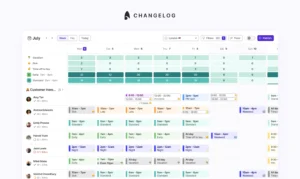
6 common issues with workforce management software

Workforce management software is designed to streamline and automate the process of managing employees in an organisation. While this type of software can provide significant benefits, it’s not without challenges. In this blog, we discuss 6 common problems that customer support teams experience with workforce management software and how to address them.
Integration issues
Workforce management software needs to be able to integrate with other systems in an organisation, such as payroll, billing, time off, CRM and HRIS systems, amongst others. Integration issues can arise if the software is not compatible with the other systems being used or if there are existing data mapping issues.
To avoid integration issues, it’s important to choose a workforce management software that is designed to work with your existing systems. As established workforce management platforms tend to be outdated, the systems they support often won’t integrate as well as modern software.
Ensuring the workforce management platform you choose integrates seamlessly with your existing systems is crucial.
Poor user experience
Workforce management software plays a crucial role in the efficiency and productivity of customer support teams. However, if the software has a poor user experience, it can actually harm productivity and the team itself in several ways.
Workforce management software with a poor user experience leads to reduced productivity, demotivated employees, increased errors in customer support operations, and ultimately, unhappy customers. It’s important to invest in software that is intuitive, user-friendly, and has the necessary features to support the efficient planning of support teams.
Choose workforce management software that is user-friendly, intuitive, and easy to use.
James Smart, former Team Lead at Cuckoo Broadband
Difficulty with scheduling
Scheduling is an incredibly complex and time-consuming process, especially in larger organisations. If the software being used does not have robust scheduling capabilities, it can lead to inefficiencies and frustration. Choosing a workforce management software that has powerful scheduling features is a must.
Often workforce management software will claim to reduce the time spent scheduling, make life easier, and automate scheduling processes. In reality, most established workforce management software just makes the user adhere to their own overly complicated scheduling engine. It often doesn’t allow teams to make bespoke shift plans, and detailed daily/weekly schedules based on their own unique intraday activities/tasks.
Surfboard is a dedicated scheduling platform that makes planning your team beautifully simple, and we can prove it.
Lack of scalability
When support teams are in their infancy, they can often get away scheduling and planning their team without the use of software. They can get by just using manual effort in the beginning but there comes a point where they inevitably scale up and get larger. It often happens very quickly. As they grow and change over time, the workforce management software they adopt needs to be able to scale with them.
If the software being used is not scalable, it can lead to inefficiencies, a lack of agility, employee burnout and low morale, and poor customer experience. To avoid these issues, it’s vital to choose a workforce management software that can scale with the organisation and the support team as they grow.
Luke Bishop, Head of CX, KatKin
No customisation
Every organisation has unique needs when it comes to workforce management. Some support teams have very rigid, standardised shift patterns. Others have agents all over the world working in multiple time zones and on various different shifts. With hybrid and remote working, It’s rare that a support team doesn’t have very specific needs.
Teams need to use software that allows them to be flexible yet organised and in control. If the software being used is not customisable, it may not be able to meet their unique needs. This leads to frustration, inefficiencies, attrition, and poor customer experience.
To remedy this, support teams should make it a priority to use software that suits their needs, rather than make their team adhere to its limited set of functionalities.
Cost
Workforce management software can be very expensive, particularly for small or mid-sized organisations. If the cost of the software is prohibitive, it may not be a viable option. Often support teams will shop around for software that isn’t too expensive and suits their unique needs.
The problem is that a lot of the established workforce management platforms out there come with huge price tags. The reason being that they’re bloated with a lot of features. They think like follows: “we have more features, so we can charge more, right?”.
This is an outdated way of thinking about workforce management software. Software with a more focused feature set like shift planning, forecasting, and scheduling is more suitable for support teams, while proving much more affordable compared to traditional workforce management systems.
Surfboard is better suited to customer support teams and is more reasonably priced.
Workforce management software vs Surfboard
Workforce management software isn’t an inherently bad thing. It plays an important role in the functioning of many organisations, particularly in customer support. But in its current state, it’s broken.
It needs to stop tracking and surveilling people, treat them as people and not resources, and work for teams’ unique needs, not force them to adhere to its own outdated logic.
It needs to be more human.
Want to find out how Surfboard makes work more human through simpler, smarter, and fairer scheduling software?
Leave your email below and we’ll send you a demo:



